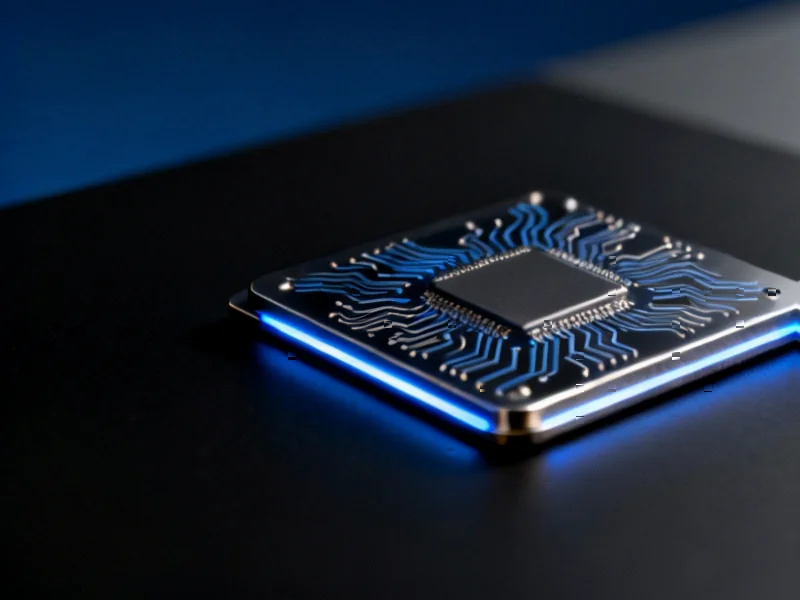The Illusion of AI Deregulation
Despite prominent free-market rhetoric surrounding artificial intelligence policy, the United States government is actively regulating critical components of AI systems through export controls and national security measures, according to recent analysis. While political leaders champion deregulatory approaches to AI applications like chatbots and image generators, sources indicate the federal government maintains what analysts describe as an “iron grip” on the fundamental building blocks of AI technology.
Table of Contents
Chip Controls as Covert Regulation
The report states that both Trump and Biden administrations have heavily intervened in the AI chip market, implementing export restrictions targeting competing nations. Under President Biden, these controls expanded to include advanced semiconductors and even model weights—the proprietary algorithms that transform user queries into AI-generated responses. These regulatory actions, buried in dense administrative documents with titles like “Implementation of Additional Export Controls,” represent what analysts suggest is a strategic shift from regulating visible applications to controlling underlying infrastructure.
“The US isn’t deregulating AI—it’s regulating where most people aren’t looking,” the analysis concludes. “Beneath the free-market rhetoric, Washington actually intervenes to control the building blocks of AI systems.”
Global Regulatory Shift
According to reports, countries worldwide are adopting different approaches to AI governance. The European Union’s AI Act initially focused on high-risk applications in sectors like healthcare and law enforcement. Meanwhile, China has restricted certain AI models to combat deepfakes and inauthentic content. The United States, however, has positioned its regulatory efforts around national security concerns, controlling exports of the most advanced chips while maintaining a light touch on consumer-facing applications.
Analysts suggest this represents a broader global pattern where regulation is moving from AI applications to its foundational components. “Seen through the lens of the AI stack, US AI policy looks less like abdication and more like a redefinition of where regulation occurs: light touch at the surface, iron grip at the core,” the report states.
Three Waves of AI Governance
The analysis identifies three distinct phases in AI regulation development. The first wave, exemplified by the EU’s approach, prioritized societal concerns including discrimination, surveillance, and environmental impact. The second wave, adopted by both American and Chinese regulators, takes a national security approach focused on maintaining military advantage and preventing malicious uses.
Emerging now is what analysts describe as a third wave of hybrid regulation that addresses both societal and security concerns simultaneously. Research reportedly shows this integrated approach works more effectively by breaking down policy silos and avoiding regulatory duplication.
Transparency and Global Implications
The persistence of laissez-faire rhetoric creates significant challenges for international AI governance, according to the analysis. With the United States hosting the world’s largest AI research laboratories, maintaining the illusion of complete regulatory abstinence undermines global cooperation efforts. The report emphasizes that recognizing the full spectrum of AI regulation—from export controls to trade policy—represents the essential first step toward effective international governance.
“It’s hard to justify a hands-off stance on societal harms while Washington readily intervenes on chips for national security,” analysts note. The public reportedly deserves greater transparency about how and why governments regulate artificial intelligence, particularly as these technologies become increasingly central to economic and military competition.
Related Articles You May Find Interesting
- New AI Framework Predicts Battery Thermal Runaway with 96% Accuracy, Cuts Sensor
- Network Intelligence Firm Kentik Taps Channel Veteran Ken Marks to Lead AI-Drive
- Refurbished HP Slim Desktop 2023 Model Offers Budget-Friendly Computing Solution
- Texas Instruments Stock Faces Valuation Concerns Amid Market Volatility
- Banking Industry Faces $170 Billion AI Profit Squeeze, McKinsey Analysis Warns
References
- https://www.presidency.ucsb.edu/documents/remarks-the-vice-president-the-arti…
- https://www.whitehouse.gov/…/Americas-AI-Action-Plan.pdf
- https://www.cnn.com/2025/01/13/tech/china-us-biden-chips-ai-curbs-hnk-intl
- https://bidenwhitehouse.archives.gov/…/
- https://arxiv.org/abs/2505.13673
- https://papers.ssrn.com/sol3/papers.cfm?abstract_id=5270641
- http://en.wikipedia.org/wiki/Deregulation
- http://en.wikipedia.org/wiki/Artificial_intelligence
- http://en.wikipedia.org/wiki/Donald_Trump
- http://en.wikipedia.org/wiki/Free_market
- http://en.wikipedia.org/wiki/National_security
This article aggregates information from publicly available sources. All trademarks and copyrights belong to their respective owners.
Note: Featured image is for illustrative purposes only and does not represent any specific product, service, or entity mentioned in this article.



